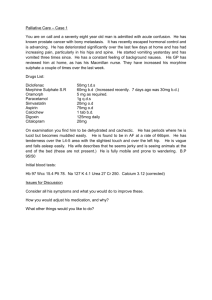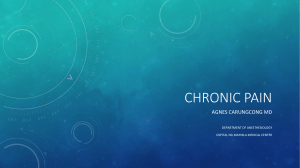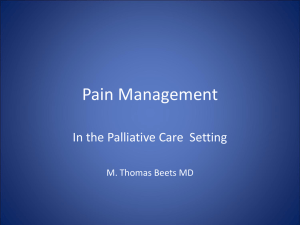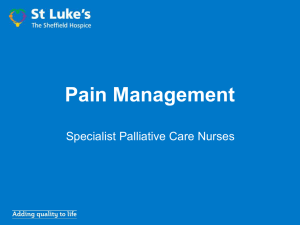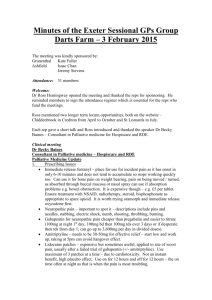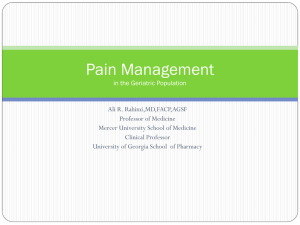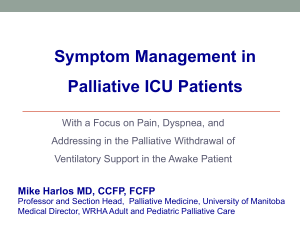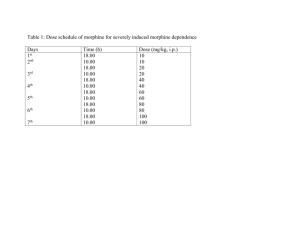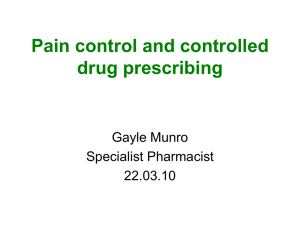North British Pain Association
advertisement
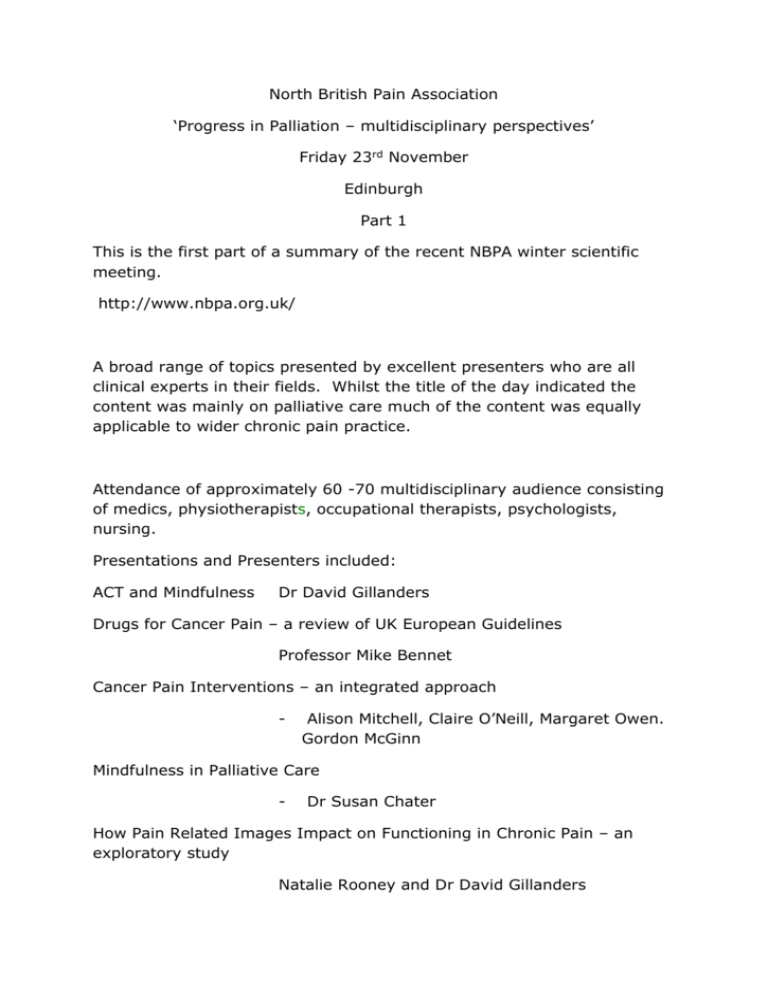
North British Pain Association ‘Progress in Palliation – multidisciplinary perspectives’ Friday 23rd November Edinburgh Part 1 This is the first part of a summary of the recent NBPA winter scientific meeting. http://www.nbpa.org.uk/ A broad range of topics presented by excellent presenters who are all clinical experts in their fields. Whilst the title of the day indicated the content was mainly on palliative care much of the content was equally applicable to wider chronic pain practice. Attendance of approximately 60 -70 multidisciplinary audience consisting of medics, physiotherapists, occupational therapists, psychologists, nursing. Presentations and Presenters included: ACT and Mindfulness Dr David Gillanders Drugs for Cancer Pain – a review of UK European Guidelines Professor Mike Bennet Cancer Pain Interventions – an integrated approach - Alison Mitchell, Claire O’Neill, Margaret Owen. Gordon McGinn Mindfulness in Palliative Care - Dr Susan Chater How Pain Related Images Impact on Functioning in Chronic Pain – an exploratory study Natalie Rooney and Dr David Gillanders Research In Physiotherapy - Emma Mair and Linda Sparks ACT and Mindfulness in Chronic Pain Dr David Gillanders, Senior Lecturer and Clinical Director of Clinical Psychology at University of Edinburgh Dr Gillanders presented a thorough and informative review of the current state of the evidence around ACT in chronic pain. He suggested at one point that ACT may be the Emperor’s New Clothes. He gave a well balanced presentation that indicates overall that the effect sizes of ACT intereventions is similar to ‘traditional’ CBT. And that in some cases it is not possible to state that the effects observed are down to specific effects or the Hawthorne effect (http://psychology.about.com/od/hindex/g/def_hawthorn.htm). When comparing CBT versus ACT there is a statistical difference towards ACT but not necessarily clinically meaningful change. Evidence from Bath indicates that more, intense treatment had better effects sizes for pain and was also very good for depression. In a most recent update by Eccleston, Williams and Morley show that ACT and CBT have a similar effect. Dr Gillanders commented on that it may be that the intensity of the treatment and activity exposure are likely to be the critical factors in optimising benefits. He noted there doesn’t seem to be any benefit of adding ‘2 extra sessions’ of mindfulness to a multi component CBT intervention. He presented an inverted triangle diagram that which showed that CBT and ACT share some similar techniques but differ in underlying philosophy i.e. whilst in practice there may appear to be similarities, the underpinning philosophy are clearly different but may get lost in clinical practice. Eccleston, Williams and Morley have recently called for a stop to CBT trials until better theories of mechanisms of change are tested for content, treatment and outcomes. Summary - This presentation compared ACT and CBT. Whilst ACT seems be promising it seems there is still work to be done to demonstrate efficacy in comparison with CBT. Drugs for Cancer Pain – A review of UK and European Guidelines Professor Mike Bennet, Leeds Institute of Health Sciences Professor Bennet provided an overview of : NICE : Opioids in palliative care: safe and effective prescribing of strong opioids for pain in palliative care of adults (May 2012) and European Association for Palliative Care (EAPC): o Use of opioids in treatment of cancer pain (2012) o Adjuvants added to opiods for neuropathic cancer pain . The guidelines are aimed at non specialist health care providers initiating strong opioids for pain in adults with advanced and progressive disease. Recommendation 1 Communication Ask patient re: any concerns about addiction, tolerance and side effects. Reassure the patient that it doesn’t mean they are at the end of life. Provide written and verbal information to patients, family and carers Offer access to review of effect and side effects Recommendation 2 Starting Strong Opioids – titrating the dose At the outset offer sustained release oral morphine and/or oral immediate release plus rescue doses of immediate release oral morphine for breakthrough pain Evidence from RCT’s shows there is no difference in efficacy between sustained release or immediate release. IN 3 RCT’s opioid naive patients had less tiredness with sustained release. Recommendation 3 First line maintenance treatment Offer sustained release oral morphine as first line maintenance with advanced and progressive disease. Do not offer trans dermal patches where oral SR is suitable. A meta-analysis showed: -Morphine versus oxycodone showed equal efficacy and no difference in side effects. -Morphine versus Fentanyl patch– there is a difference in treatment duration. 1/7 – 1/52 – no difference 1/52 – 1/12 – morphine is more effective 1month – no difference Prof Bennet went on to state that SR morphine is more effective than Fentanyl in cancer pain In non cancer pain morphine is better than buprenorphine. Main side effect in all opiates is constipation -there is no difference between either morphine or transdermalopioids and patches not considered to be cost effective Recommendation 4 First-line treatment if oral opioids are not suitable: - transdermal patches if pain is stable subcutaneous delivery if pain is unstable There is little difference in efficacy and only in constipation. Recommendation 5 For breakthrough pain: offer IR oral morphine NOT fast acting fentanyl, as first line rescue and seek specialist advice if inadequately controlled Evidence shows statistical but not clinical significance of greater effect of fentanyl spray or lozenge but fentanyl 50 x dearer Recommendation 6 Adverse effects: Constipation – prescribe laxatives Nausea – prescribe antiemetics Drowsiness – occurs but often transient – if pain controlled consider dose reduction, if not consider opioid switch EAPC guidelines overlap : Use morphine first. – no difference between oral opiates/ patients often prefer transdermals which are slightly less constipating/ use oral opioids first for breakthrough pain then FAFs, regular laxatives Opioids and Neuropathic Pain Professor Bennet then went on to discuss neuropathic pain in patients with cancer and thinks that their neuropathic pain can be due to several different mechanisms. He stated that neuropathic pain predicted a poorer quality of life compared to nociceptive pain over and above pain intensity. Oxycodone and morphine have equivalent efficacy in neuropathic pain and may out perform adjuvants. There is no difference in efficacy between gabapentin and imipramine. He then went onto report that combined anti neuropathic pain and opiates were better than monotherapy in neuropathic cancer pain. In neuropathic non cancer pain (Gilroy 2008) patients had a baseline VAS of 5.7. With placebo this reduced to 4.5, gabapentin was more effective but morphine was most effective. He finally stated that he didn’t think that there was a specific anti neuropathic pain medication. Summary: This was an interesting presentation and raised awareness of the NICE and EAPC guidelines. I found that understanding the difference between the strong opiates e.g. oral versus trans dermal will inform me in discussions with patients who think a change in there opiates will improve their symptoms. Neil Clark and Jenny Drinkell
